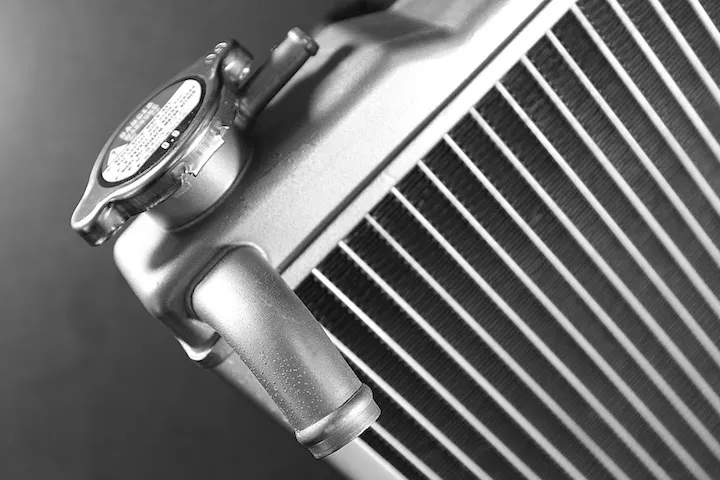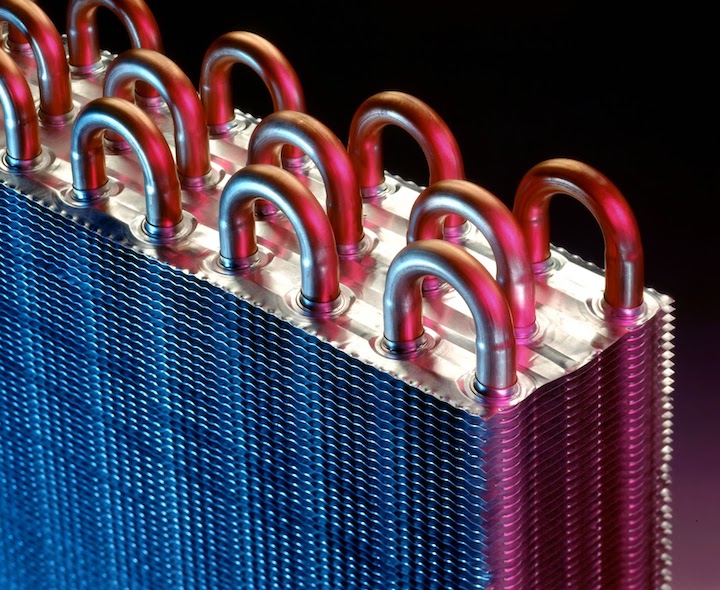Time to read: 6 min
One of my favorite jobs as a mechanical engineer was as a heat exchanger designer for commercial aerospace. While it may appear straightforward, there are a lot of considerations in good heat exchanger design, including:
- Mechanical strength to resist bursting due to high pressure
- Geometry constraints (fitting effective heat exchangers into small footprints)
- Fluid flow optimization and calculations
- Pressure drop optimization
- Mechanical power needed to overcome fluid friction
- Heat transfer rate between fluids
- Fluid flow channel sizing and geometry (surface area density)
- Material selection for the coefficient of friction, coefficient of thermal expansion, heat transfer characteristics, and material compatibility
Now, I could rant for days about optimal fin design, methods for joining plates and fins, and even flow-stream mechanical energy losses, but this article is focused on material selection for heat exchanger design. Choosing the right material is critical to the success of your heat exchanger design because making a good choice enhances your design, while the wrong choice can cause it to fail.
What Impact Does Material Selection Have on Heat Exchanger Performance?

Heat exchanger material should be chosen based on its physical material properties like thermal conductivity, temperature resistance, corrosion resistance, and strength — plus non-stable supply chain considerations such as cost and availability. The wrong material can lead to higher cost and longer production times if it’s more difficult to machine and weld.
Material selection has a direct impact on the ability of the heat exchanger to exchange heat from one fluid to another. If you select a poor material, you’ll suffer negative impacts on the rate of heat transfer, drops in pressure, and you may even require excess mechanical power. On the other hand, correct material selection for heat exchanger design allows you to optimize performance, efficiency, cost, and potentially find savings in weight or achieve a smaller footprint.
What Material Properties Should You Look for In Heat Exchanger Design?
As mentioned above, these are the properties you should look to optimize when designing a heat exchanger:
- Thermal Conductivity: Thermal conductivity is the measure of a material’s ability to transfer heat. Higher thermal conductivity materials allow more efficient heat transfer, which improves the performance of your design.
- Temperature Resistance: Temperature resistance is the measure of a material’s ability to withstand high temperatures without deformation or compromising strength.
- Density//Weight: Often, heat exchangers are designed for applications that require lightweight parts or where increases in weight decrease fuel efficiency — as with aerospace applications.
- Corrosion Resistance: Corrosion resistance is the measure of a material’s ability to resist corrosion from chemical and environmental conditions and is especially critical if a heat exchanger will be subjected to harsh conditions.
- Strength: Strength is the measure of a material’s ability to resist mechanical forces. Increased mechanical strength is required for applications that contain fluids at high pressure or will be subjected to heavier loads.
- Cost and Availability: Cost and availability are self explanatory — you always want the best functional materials at the lowest cost.
Now, of course, not all materials provide an optimized combination of mechanical properties, cost, and availability — you’ll have to sacrifice one factor over the others to complete your design.
Pro-tip: To see how material properties impact CNC machining and how to design for manufacturability, check out our on-demand webinar, DFM for CNC Machining: Minimize the Challenges with Design for CNC Machining.
The Best Materials for Heat Exchanger Design

The best materials for heat exchanger design are materials with a combination of high thermal conductivity, high temperature resistance, excellent corrosion resistance, good mechanical strength, low cost, and wide availability.
Copper
Copper is the most well-known metal with high electrical conductivity. Copper also has a high thermal conductivity due to its lattice-like atomic structure, which allows efficient energy conduction throughout the material. The number of free electrons in each atom of copper also allows for fast and efficient movement of energy via thermal or electrical conduction. This high thermal conductivity means that heat transfer from the hot to cold fluid will occur as efficiently as possible and with as much speed as possible.
Copper also provides excellent corrosion resistance, fluid compatibility, and good mechanical strength. Copper comes in many alloys that are generally readily available and relatively inexpensive. In addition, it’s relatively easy to machine and weld, making it suitable for multiple manufacturing methods. Copper is especially suitable for tube and shell heat exchangers thanks to its high ductility — which allows it to be drawn into thin-walled tubes or extruded into small wires without fracturing.
Stainless Steel
Stainless steel is known for its high mechanical strength and excellent corrosion resistance, which comes from its naturally occurring, protective oxide layer. Stainless steel also has good thermal conductivity, which is why the material is an optimal choice for heat exchangers that must withstand ultra-high temperatures, high burst pressure, and extremely harsh environments.
Stainless steel is stronger than aluminum, carbon steel, and copper, and its mechanical strength is preserved at higher temperatures than other common heat exchanger metals. This reduces the potential for distortion or warping over extended exposure to extreme temperatures. Stainless steel is also simple to machine and weld, which makes it easier to fabricate and assemble heat exchangers.
Aluminum
For most commercial aircraft, various grades of aluminum are the predominant choice for heat exchanger material because it’s strong, yet lightweight. It’s the most common metal on earth, so it’s readily available and cost-effective. Aluminum also has a naturally occurring, protective oxide layer that can be modified to be stronger. Aluminum is ductile enough to be drawn into thin tubes or rolled into thin sheets and formed into fins with complex geometries. Aluminum also has excellent thermal conductivity, though it isn’t able to withstand temperatures above a few hundred degrees Fahrenheit.
Aluminum can be readily brazed with methods like aluminum fluxless vacuum brazing, which creates a strong joint that can withstand the pressure of a heat exchanger. During brazing, the aluminum oxide layer cracks because it’s more brittle than the underlying metal. This cracking occurs at high temperatures right before the braze metal melts and fills the gaps between the oxide layer, and a gettering agent is used to prevent the oxides from reforming. While aluminum isn’t suitable for all heat exchanger applications, it’s generally the first material I would recommend.
Titanium
Titanium has only been prominently utilized in manufacturing since the early 1900s. (Though it was discovered in 1791 by an English pastor!) Titanium has many excellent material properties that make it suitable for heat exchanger construction — it’s lightweight, corrosion-resistant, and has good heat transfer properties. I think of titanium as a supercharged cousin of aluminum that provides many of the same valuable material properties, but on a higher scale — except for its thermal conductivity, which is lower than aluminum. Still, titanium boasts the highest operating temperature on this list, and that tradeoff may be necessary in some applications.
Titanium is about 1.5x more dense than aluminum, but its strength is 4-5x higher than aluminum, so using titanium can result in significant weight savings. However, a common misconception is that titanium is lighter weight than aluminum — the truth is that you get the same load capacity from less titanium than you get with the same amount of aluminum. This is why many aerospace companies, car manufacturers, and even medical device companies are utilizing titanium more in order to meet requirements to minimize weight and increase strength.
Comparison of the Best Materials for Heat Exchanger Design
Now that you know the pros and cons of the materials, you can utilize the tables below — which have the key data points for each — to simplify material selection for your next heat exchanger design:
| Thermal Conductivity (BTU/hr*ft*F) | |
| Copper | 6.95 |
| Stainless Steel | 0.285 |
| Aluminum | 4.14 |
| Titanium | 0.15 |
| Highest Operating Temperature (F) | |
| Copper | 1982 |
| Stainless Steel | 1500 |
| Aluminum | 300 |
| Titanium | 1648 |
| Density (lb/in^3) @ Room Temp (68F) | |
| Copper | 0.323 |
| Stainless Steel | 0.285 |
| Aluminum | 0.098 |
| Titanium | 0.163 |
| Corrosion Resistance | |
| Copper | High |
| Stainless Steel | High |
| Aluminum | Moderate |
| Titanium | High |
| Tensile Strength (lb/in^2) | |
| Copper | 37000 |
| Stainless Steel | 75000 |
| Aluminum | 35000 |
| Titanium | 12000 |
Key Takeaways: Heat Exchanger Material Selection
- How do you select a material for a heat exchanger?
Heat exchanger selection should involve a tradeoff between material properties like thermal conductivity, tensile strength, maximum operating temperature, density, and corrosion resistance versus availability and cost.
- What is the best material to use for a heat exchanger?
Our recommendations for heat exchanger material are copper, stainless steel, aluminum or titanium.
- What are the factors for selecting reliable heat exchanger tube materials?
Fluid compatibility, tensile strength, and ductility are all important factors to consider when selecting a material for heat exchanger tubing.
- What is the best material for condensing heat exchanger for steam?
Stainless steel is a good choice for handling condensing steam heat exchanger applications because it’s corrosion-resistant, resistant to high temperatures, and thermally conductive.
Complex Parts at Ridiculous Speeds – Start Your Next Project With Fictiv
For all your heat exchanger CNC machining and finishing needs, Fictiv has you covered. No matter how complex your designs, we’re experts at producing custom CNC machined tight tolerance parts in a variety of materials. We simplify custom part sourcing with intelligent, streamlined, automated workflows that deliver high quality mechanical components fast. Fictiv is your operating system for custom manufacturing that makes part procurement faster, easier, and more efficient.
Create an account and upload your part to see what our instant quote process, design for manufacturability feedback, and intelligent platform can do for you.








